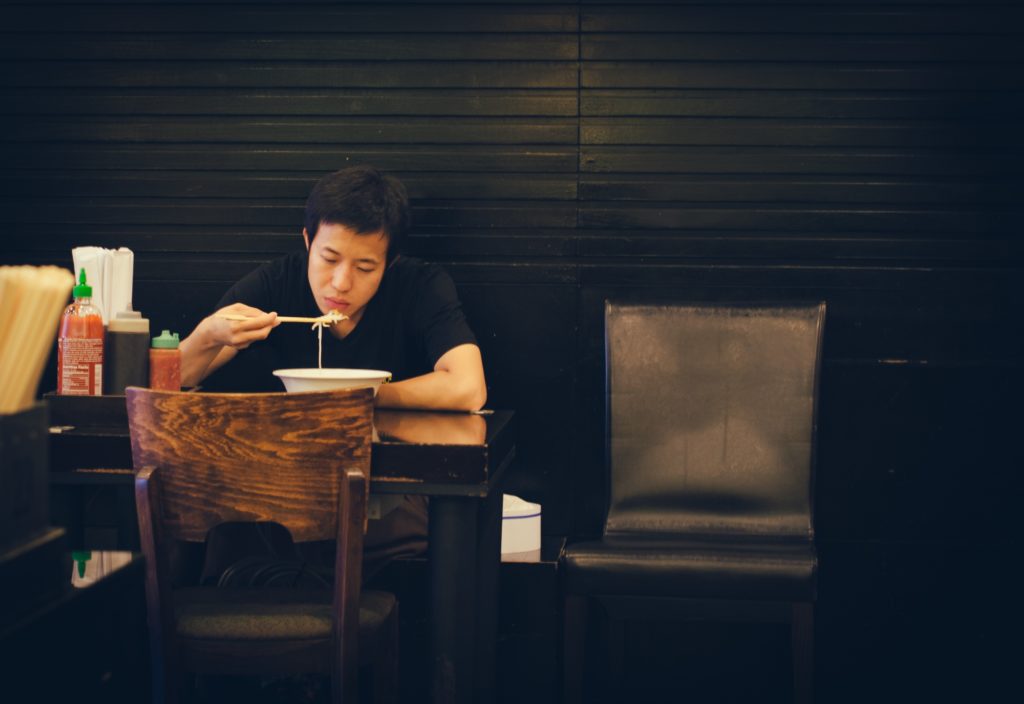The Peninsula
Table for One?: How Dining Culture Is Changing in South Korea
Published April 10, 2017
Category: South Korea

By Gwanghyun Pyun
One of things you might observe when you visit South Korea is that there are very few people who dine alone. In Korean dining culture, all family members have breakfast and dinner together at their house. It is also common for children to have lunch with their classmates at school and workers to have lunch with their coworkers. Furthermore, many Korean companies regularly hold ‘company dinners,’ which every worker is encouraged to attend to help develop company unity. Eating together is so common in Korea that those who dine alone can be seen as having few friends or lacking social skills.
However, the number of Korean people who dine alone at home and work is increasing. Although Korea has a strong dining-together culture, more people are starting to accept the idea of dining alone. Korean people call this dining alone behavior ‘honbap’ (“hon” means alone and “bap” means meal in Korean). Korean media commonly attribute the increase in the ‘honbap’ trend to changes in the Korean society – including the fact that society is becoming more competitive as well as the growth of individualism and an increasing number of single-person households.
At first, the ‘honbap’ trend became popular among university students who were under high levels of stress due to competition in the job market. It is difficult for university students to plan meals with friends. They are often too busy making themselves more marketable by preparing for job tests, improving their language skills and engaging in the community service activities that are major requirements to get a job. Many students started to consider dining together a waste of time and money and realized that dining alone is more convenient.
Korean office workers face similar challenges. Even after getting a job, they face fierce competition for promotion or survival in the work place. Some of them want to save lunch time by eating alone and then use lunch time for building their professional development such as learning English, studying skills related to their professional area and taking certification courses. Professional development has become so important that some language institutes have offered lunch time classes that serve a light lunch. Thanks to this trend, many restaurants began catering to a growing market of solo-diners. Most restaurants in Korea in the past had menus and tables set up for group customers, to the point where people could only order food in portions for two or more people. But now many restaurants have rearranged table formations as well as menu in order to accommodate solo diners.
The ‘honbap’ trend has also become popular in people’s homes due to the increasing number of single-person households. According to Statistics Korea, single-person households accounted for about 15.5 percent of the total population in 2000, but increased to 27.1 percent in 2015. Among single-person households, 91.8 percent of them tend to dine alone. This change has affected all ages, mainly due to the delayed marriage age and increasing divorce rate. Since the number of single-person households has increased, it has become less common to see all family members dine together every day like they used to.
The cultural transition from collectivism to individualism in Korean society has also contributed to this trend. According to Professor Kwak Geum-ju at Seoul National University, people feel so tired of meeting others that they prefer to spend more time alone. This is because when they have meals together, they must take others’ food preference, daily schedule and even financial situation into consideration. In addition to their busy lives, Korean people have also become tired of Korea’s collectivist culture, resulting in more people deciding to dine alone.
Now, not only do Korean people dine alone, but also they drink, watch movies, and sing karaoke alone. Professor Jeong Do-un at Seoul National University explained that the dining alone phenomenon means that Korean society is gradually shifting away from a group-based society. Many Koreans are realizing that they do not need to spend their time and money to blindly maintain groups, and instead can focus on their individual lives if they choose to.
The ’honbap’ trend also has some downsides. For example, some people choose to eat alone out of convenience. Others, however, are compelled to eat alone due to their small social network or even insufficient finances. For them, ‘honbap’ means that they do not have a person to communicate with or cannot afford social activity. In addition, there is research that shows people who dine alone tend to have poor health due to irregular meals and social phobia. The fact that the trend is based to a certain extent on the increasing number of single-person households and on competitiveness in society hints at the some of the negative aspects of this trend.
Compared to many Western cultures, eating alone is a concept that is rather foreign to many Koreans. Nevertheless, ‘honbap’ behavior is a rapidly growing trend that is changing dining culture in Korea. According to a survey by Ministry of Agriculture, Food and Rural Affairs, 56.6% of the respondents said they have dined out alone. And people who belong to single-person households, which make up 27.1% of total households, must eat alone at home every day. Many have come to an understanding that dining alone is not a strange behavior but part of a reasonable lifestyle for those who choose it for their own convenience. But Korean people should keep in mind that they also need to maintain balance between convenience and social life.
Gwanghyun Pyun is currently an Intern at the Korea Economic Institute of America as part of the Asan Academy Fellowship Program. He is also a student of Sogang University in South Korea. The views expressed here are the author’s alone.
Photo from Guian Bolisay’s photostream on flickr Creative Commons.
